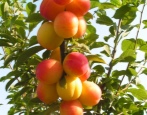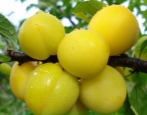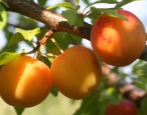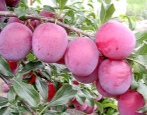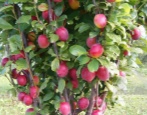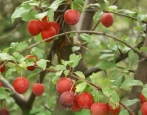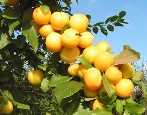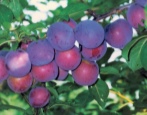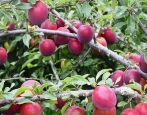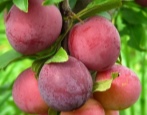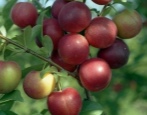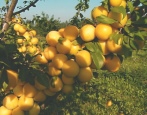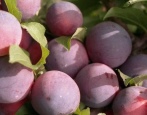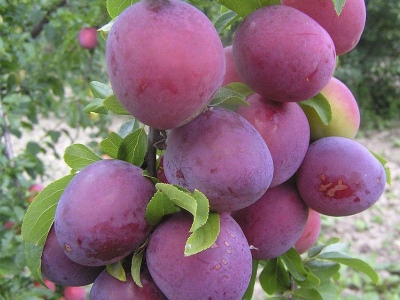
- Authors: K.F. Kostina, O.A. Zobranskikh (State Nikitsky Botanical Garden)
- Appeared when crossing: Chinese plum Burbank x Tavricheskaya cherry plum
- Year of approval: 1969
- Growth type: medium-sized
- Ripening period: average
- Self-fertility: self-infertile
- Fruit size: large
- Yield: high
- Appointment: for canning, for fresh consumption
- Transportability: good
Cherry plum Abundant is a garden variety, highly valued for the excellent appearance and marketability of fruits, their taste. It is actively grown on an industrial scale, with bountiful harvests every year. The variety takes root well in summer cottages, but only in a sufficiently warm climate, since the plants do not tolerate cold well.
Breeding history
This cherry plum was approved for use in 1969. The specialists of the State Nikitsky Botanical Garden were engaged in the development of a new variety. In the crossing, the Chinese plum Burbank x Tavricheskaya cherry plum were used.
Description of the variety
The trees are medium-sized, with a sparse flat-round crown. They are grown on boles with dark gray bark, not very thick, even and neat. Shoots are directed horizontally, with a green top and a reddish-brown tan along the entire length. The leaves on them are large, smooth, green, with slight pubescence on the lower part. During flowering, the tree is covered with white buds with highly corrugated petal edges.
Fruit characteristics
Cherry plum of this variety has a basic yellow color with a cover of a red-violet hue. Fruits are large, with an average weight of 35-40 g, asymmetric, close to round or slightly flattened. The abdominal suture on the surface is clearly visible. The skin is of medium density, without pubescence, covered with a waxy bloom, easily separates from the pulp. The inside is medium in size.
Taste qualities
The fruits are suitable for canning, eating fresh. Do not wrinkle during transportation. The taste is pleasant, sweet and sour, without pronounced astringency. The variety received a tasting score of 4.4 points.
Ripening and fruiting
A variety of medium ripening. Cherry plum bears fruit Abundant at the end of June. The first crop can be tried the next year after planting.
Yield
The collection reaches 111 c / ha. According to this indicator, Abundant cherry plum belongs to varieties with high yields. From a tree aged 10 years and older, you can get 40-60 kg of fruit per season.
Growing regions
The variety is zoned for the North Caucasus region. Needs enough active insolation.
Self-fertility and the need for pollinators
Abundant - self-fruitless cherry plum, in need of cross-pollination. Plums are planted nearby with similar flowering dates - in mid-April. Also suitable for cross-pollination of spherical cherry plum.
Growing and caring
It is customary to plant the variety in spring, at the beginning of April, acquiring seedlings with a closed or open root system, healthy and strong. For placement, it is best to choose the south side of the site, without shade blocking the sun, but with protection from strong winds. Cherry plum is hygrophilous, grows well in areas with shallow groundwater. The acidity of the soil is preferably neutral.
In plants with an open root system, preliminary preparation must be carried out on the eve of planting. Dry and dead parts of it are cut off with a sharp disinfected pruner. The browned part is removed until a light beige color appears.Then the roots, right before transferring to the ground, are briefly dipped in a chatter box made of a liquid mixture of clay and mullein. It will be useful to add insecticidal additives to this mixture to protect the plant during the adaptation period.
The pit for planting is not prepared too deep, up to 50-60 cm. It is filled with a mixture of turf, humus and pure clay. It is not required to lay fertilizers on black soil. The seedling is placed in the center of the hole, the roots are unraveled, straightened, the neck is left above the soil level. A supporting peg is installed next to it - 1 or 2.
If a garden of fruit trees is formed, they are planted in rows, according to a 4 × 5 m scheme. This distance will leave enough space for the crown to grow.
Cherry plum Abundant requires attention and care in preparation for winter. During this period, in October-November, the annual pruning of branches is performed, the fruiting, dried, dead shoots are removed, the rest are shortened. Also, abundant water-charging watering is carried out with 5-6 buckets of warm settled water.
You need to form a tree so that it has 4-5 skeletal branches. Lateral growth is removed by 25-30 cm. When forming, all shoots growing from one place, as well as those extending from the trunk at an acute angle, are removed.
The rest of the time, leaving will not be too difficult. Plants need to be watered regularly, especially in hot weather. They do not tolerate long-term lack of moisture. You can organize drip irrigation in the garden. It is necessary to fertilize mature trees three times a year, before and after flowering, as well as at the end of fruiting. With excessively abundant fruiting, the ovaries are rationed, additional supports are installed to avoid breaking the branches.
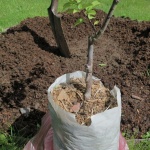
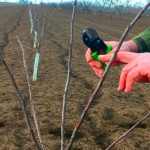
Disease and pest resistance
Abundant has an average resistance to diseases such as clasterosporia, bacteriosis, moniliosis.

Requirements for soil and climatic conditions
Trees have low drought resistance. Winter colds endure medium. They need a warm climate without early spring frosts.
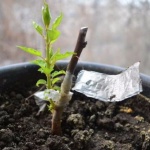
Review overview
According to gardeners, Abundant cherry plum is a good choice for growing in private backyards - for personal needs and for sale. It is grafted on the collective farm Renklod plum, and sometimes even on apricot trees. Practical experience shows that the tree takes root well in the climate of Ukraine and the Krasnodar Territory, does not freeze out in relatively warm winters. Gardeners praise this cherry plum for the one-dimensionality of the fruit, and also advise to pick it at the stage of full maturity, when the flesh turns almost red, so that the fruits gain flavor. With early pick-up, it does not improve, even if given the right time.
Due to the dense pulp, the fruits are suitable for freezing and canning in halves, in syrup. Fresh ripe cherry plum, in addition to its excellent taste, gardeners also note a very pleasant rich aroma.
The disadvantages of the variety include the weak fixation of cherry plum on the branches at the harvesting stage. If you miss the time, there will be many Padans. Also, a strongly growing crown has to be regularly shortened, removing about a third of the growth length.

